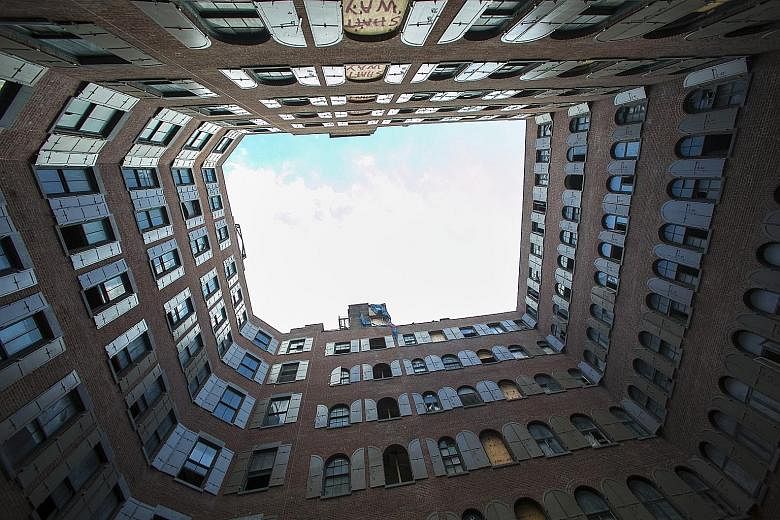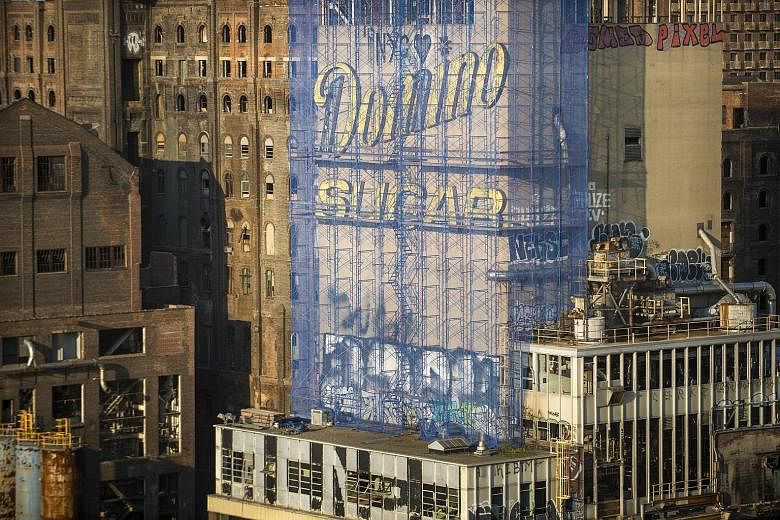NEW YORK • The blue-collar shop floors fall silent, find new life as artists' studios, then exchange their 19th-century guts for 21st-century marble bathrooms and private gyms: So goes the story in a city where time does not stand still for long and a neighbourhood's shifting fortunes can be told through its old warehouses and factories.
In the process, the city coughs up timbers that were logged and hoisted into place when it was almost young.
New York is the country's largest repository of the lumber that formed the spine of the Industrial Revolution - a five-borough safe deposit box for New England white pine and spruce, Pacific Northwest Douglas fir and, especially, Southern longleaf pine.
Vast hoards of longleaf pine are entombed at each base of the Brooklyn Bridge. It once underpinned the New York City subway tracks. It endured the trampling of 150 years of Domino Sugar Factory workers in Williamsburg, buttressed the warehouses of Tribeca and bore the weight of Brooklyn's waterfront depots.
Now the sugar factory is being converted into condominiums; Tribeca lofts are among the city's most expensive real estate; and the East River storehouses have been razed to make way for more condominiums. And longleaf pine has found new purchase.
The timber of the industrial age now graces Thomas Jefferson's Monticello and the stately Maryland chamber where the Continental Congress once met.
You can walk on it at the new Whitney Museum and New York's Patagonia flagship store.
Much of it is being reclaimed by the region it was hauled away from, when northern timber barons descended on the south's hectares of virgin pine after the Civil War.
"The south was an extraordinarily poor region then and was nothing but a resource base and most of this wood came to New York," said Mr Larry Stopper, a partner at reclaimed lumber firm Bigwood. "Now the industrial cities of the north are transforming themselves and the south has plenty of money, and people want their old wood back."
By now, as most people know, reclaimed wood - salvaged from sources that include bourbon tanks and mushroom farms - has gone mainstream.
In the case of New York City, salvaging wood also means salvaging the city's past.
As the timber industry gobbled up north-eastern and western forests, it began turning to the longleaf pine, also known as yellow or heart pine, that covered as much as 36 million hectares from south-eastern Virginia to eastern Texas and northern Florida.
Some of the trees were three centuries old.
Dense, durable and saturated with resin that made it unusually resistant to rot and insects, the timber proved rough work for builders to mill.
But in the decades before steel began to dominate, longleaf pine was the strongest material around.
"Everybody in the wood business says the longleaf pine tree is the best wood the Lord ever made," said Mr Pat Fontenot, owner of Olde Wood Accents in Washington, Louisiana, an antique pine dealer. "If it hadn't been for the longleaf pine tree, we wouldn't have been able to do the Industrial Revolution."
The largest mass of longleaf pine in the city probably sits under the two towers of the Brooklyn Bridge. Completed in 1883, the bridge was built using caissons - enormous airtight timber chambers that engineers sank into the riverbed, allowing workers inside to dig deeper into the earth below and workers above water to construct stone towers on top.
By 1938, the Great Southern Lumber Co, based in Pennsylvania, had sold its last longleaf pine log.
Only about 3 per cent of the original old-growth forest survives, according to the US Forest Service. Pine harvested today comes from farmed trees.
The only way to find original- strength longleaf pine these days: Mine it from buildings such as the Domino Sugar Factory or 443 Greenwich Street in Tribeca, the brick-and-mortar vertebrae of northern cities' industrial might.
"It's a southern tree that has been part of New York City for 150 years," said Mr Alan Solomon, owner of Sawkill Lumber, who hunts down old lumber, during a recent trip to the Tribeca building. "The city's always reinventing itself. Stuff's always getting knocked down."
It took his team a year and a half to strip the brick-and-stone Romanesque Revival plant in Tribeca, finished in 1883, of all its pine. The building's tenants have included the Novelty Toy Co, which is said to have produced the first teddy bear; the American Steel Wool factory; a printing house; and, as manufacturing jobs drained out of the city, studios for architects, film-makers and artists.
Its newest incarnation is as 53 large, lavish condominiums financed partly by a Russian billionaire. The asking price for one of the most expensive units is US$53 million (S$72.7 million).
The building's lumber was stripped of nails, dried, milled and sometimes stained again.
Some of the wood was originally logged not far away in Bogalusa, Louisiana. These days, it can go for as much as US$14 a board-foot.
But not all of the pine returns to the south. Wood from the Domino factory lends the Patagonia and Filson stores in Manhattan authentic-looking backdrops to ultralight down jackets and rugged-look briefcases.
At the Roosevelt Island duplex of Ms Nina Tandon and Mr Noah Keating, both born-and-bred New Yorkers, the wood pays homage to their native city.
In Brooklyn itself, the pace of recycling has quickened, with warehouses and factories along the borough's north waterfront being razed or converted.
A few years ago, a complex of cold-storage warehouses by the Brooklyn Bridge that once stored perishables shipped to the city was torn down to make way for Brooklyn Bridge Park.
The pine that once buttressed floors and roofs became benches, picnic tables and playground equipment.
What preserved the lumber's strength for 170 years now protects it, not too far away, from the snow, the rain and the sun.
NEW YORK TIMES


